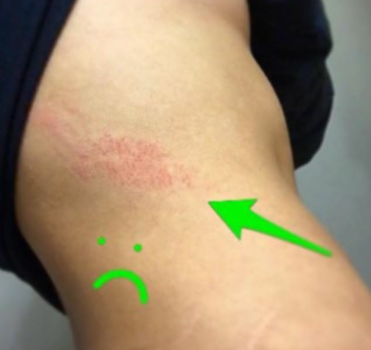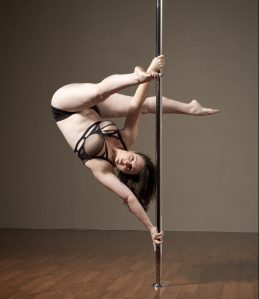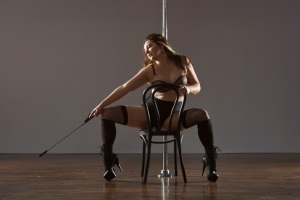Is Freedance Suited for Competitions?
I spent last weekend judging PSO’s Pacific Pole Championship, as I do every year. I genuinely enjoy judging – I love seeing what people bring to the stage, but more than that, I really enjoy the process of providing feedback. I hope what I tell people is constructive (and that nobody thinks I’m a bitch for giving them suggestions of things to improve) – and I look at it as an opportunity to learn how to better coach our competitors as well. An example of this: the scoresheets for 2019 are different than in previous years, so we judged on a new criteria, and it completely changed how I awarded points…and it will change how I coach people in the future.
Another change for 2019 was the reintroduction of the Freedance category. I remember this being around when I first completed in 2012 – at that time, competitors were assigned a song and able to hear it a few times right before they went on stage. For this year, the competitors did not hear their music until they stepped on stage.
I was part of the judging panel for both of the Freedance categories at PPC, which were split into Junior/Senior and Master/Grand Master – since this is considered an experimental category, there were no levels assigned, only age brackets. This was also how things ran when they first introduced the Low Flow category, too.
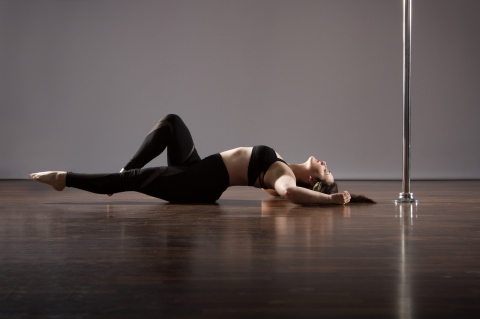
Freedance photo by Alloy Images.
I’m super grateful to have been a part of the judging process for this, but it got me thinking quite a bit about Freedance/Freestyle and the misperceptions of it within the pole community.
I teach Freedance weekly, and I have for around 4 years. Before that, I was invested in it as a student. If there was any genre within pole that feels like mine, it’s this one. I’m deeply connected to it in a way that makes me excited to share it, but also protective of what I believe it to be.
To me, freestyle is about connection: to an audience, a story, a character/being, an emotion, or another prompt of some kind – it’s driven by a focus on that parameter, and that’s what I look for in the technique: are you connected to or focused on something that is larger than tricks?
I would venture to guess that this is NOT what most people would look for when watching a Freedance Competition Category, largely due to a lack of understanding of Freedance Technique (including that it even exists as a thing).
My feeling on this is obviously colored by the fact that I teach freestyle technique: there IS a technique to it, but it is not the same type of technique one would see in other categories, and very few people seem to understand it because freestyle is so rarely taught.
What I am looking for in technique for freestyle is different from what a non-freestyler would look for…I don’t care so much about trick passes, for example. I’ll forgive cleanliness to a certain degree, in favor of other elements I consider more important for the genre. I don’t give a shit if you go up the pole at all – in fact, in my class, the majority of students stay at the base (I can count on one hand the number of students I have had who have gone up the pole with any regularity). Going up the pole doesn’t show me anything about your Freedance Technique unless you do the work to incorporate it into your aerial work.
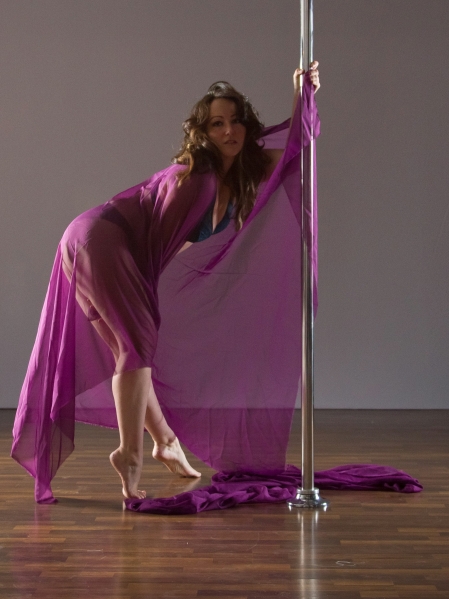
Photo a fabric freedance by Alloy Images.
Do I feel like Freedance has a place in competitions? Yes. I do. I’m actually really excited about the idea of it, because it means that there’s a chance that Freedance will a) become more widely understood, accepted, and even celebrated and b) more people might be willing to try it.
That said: I think there’s an opportunity to educate pole competitors on how to work within the genre for competition, as well as for judges to learn what to look for while judging. PSO stated that the category was judged on a technical scorecard because it’s still experimental, and the artistic scorecard includes elements that would be difficult to apply (which is true, from my experience) – I’m curious to see if they develop a new scoring system for this category, if they continue to include it – or if they provide any other training/education around the concepts of Freestyle Technique.
Do you have thoughts on Freedance in competition? Comment below!
Are We Bitches?
[This piece was previously published on the now-defunct Bad Kitty Blog.]
Quick, answer this question:
Which studio is your home?
You probably had one clear answer. And, if you had to explain why that studio was the one you considered HOME, I bet at least some of the answers would look something like:
“It was where I started.”
“Everyone is so friendly!”
“I’m really close with the other students.”
“I love my teachers. They’re so supportive!”
Those are all great reasons! For me, I know that even when I don’t go to my original studio as often as usual, I still consider it home. It was where I began, but also, it’s where I feel accepted and comfortable. I have good friends there, and I love the vibe – it’s as if magic fairy dust has been sprinkled into the walls, blocking the outside world from coming in.
This special energy can be hard to find in other studios. Maybe it’s because nothing is going to match your Home Studio, but maybe it’s more than that. I’m lucky enough to live in a city with a preponderance of studios to choose from. There is an embarrassment of riches in this community, and many choices one could make as to where to spend their pole time. I’ve taken classes at eight of the major studios in the LA metropolitan area, and I like different things about all of them. But I definitely have my reasons for returning to some studios over others. It’s been a lesson in learning how to navigate within a community without my wolf pack of pole sisters to protect me. I’ve had to learn how to work in new environments, how to adjust to the different levels of instruction offered at various places, and how to not take it personally when a studio doesn’t live up to its expectations, or if people aren’t super welcoming.
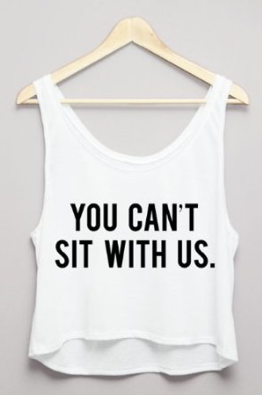
I forget, though, that not everyone is used to moving around into new spaces. I was speaking to a friend of mine, who was excited about the chance to try a studio new (which shall remain nameless). During her first class, she watched with dismay as the students did not greet her or celebrate the wins of others, and the instructor failed to welcome her or support the other students in an open and friendly manner. Both of these experiences were the polar opposite of life at her usual studio and left her with such a bad taste in her mouth. She decided to not continue with the remainder of her classes at the new studio.
I know that feeling. I’ve experience the same thing, and I’ve heard from others that it’s not uncommon. It got me to thinking: As pole dancers we have a tremendous opportunity to empower ourselves and others, but have we evolved? Do we breed exclusivity in the name of empowerment, only to blind ourselves to the fact that this type of empowerment is often built on the disempowerment of others?
Are we still in high school?
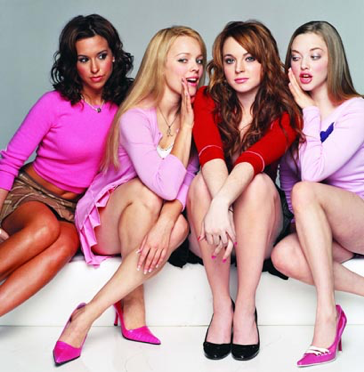
Think about it: we all want to be better, we all want to DO better, but in the pursuit of that, do we exclude people who ultimately want the same thing? How is that empowering to anyone but you? And, really, is it actually empowering to you? I would venture to say that excluding others and failing to celebrate their victories is the road to disempowerment, rather than empowerment.
And, I don’t just mean, celebrate the victories of your friends. Take a moment and remember what it’s like to be The New Kid. Look around and reach out to someone you don’t know. Cheer for all of the victories you see. Offer to spot someone who needs it, but hasn’t asked. Compliment someone on a move they were trying, even if maybe it’s got some room to go before it is perfect. Give back. Share. Banish the bitch. You’ll be stronger for it. We all will.
The Cost of Being a Pole Instructor
So you want to be a pole instructor? Awesome! First, head over to the Alloy Images blog for a fun take on the joys (and occasionally not so fun, but still funny aspects) of being a pole instructor. They do a great job at covering it with glee!
Now, let’s get down to the serious stuff. Being a pole instructor comes with a lot of responsibility (duh), but what may not be obvious is that it can also cost a lot. Not just financially, but physically and emotionally, too. I’ve been thinking about this off and on, discussing it with my friends who teach, and I’ve finally put together a list of costs associated with teaching pole – with some bonus help from members of one of the excellent, private Facebook groups dedicated to teachers and studio owners. (Thanks all!)
FINANCIAL COST
You might think that teaching pole is a means to extra income. Sometimes, that is true! Buuuut, not always. Here are some costs to consider:
Insurance
If you are teaching pole, you must have proper instructor insurance. To not insure yourself as an instructor is to leave yourself open to potential lawsuits should a student be injured in your class. While studios should have their own insurance, that coverage will vary (it may not cover you as an instructor), and you should ALWAYS protect yourself, regardless of the level of insurance at your studio. Do your research into coverage; make sure you choose a plan that covers pole. Personally, I have insurance through Alternative Balance. They offer options for part-time and full-time instructors, plus they specifically cover pole. My yearly rate comes out to just over $200, before adding my studio as an Additionally Insured. Make sure that you add every studio you teach at to your policy – this can cost anywhere from $10 to $25 per studio, on top of your premiums. Other policies are out there, and they can be expensive!
As a pole instructor with a muggle job that provides me with health insurance, I am afforded the privilege of not having to pay for it fully out of pocket. But if you plan to make pole your central means of work, health insurance is something for which you will need to budget – you do NOT want to get injured without coverage. Trust me. Plans will vary, but when I was getting insurance through the Affordable Care Act (aka Obamacare) from 2013 to 2014, I went through Covered California and saw plans that provided bare bones coverage for very little, to “Cadillac” coverage plans that cost a few hundred dollars a month, even after subsidies (at the time, I was making about $24,000/year, so my subsidy offers were decent, and I went with a medium level plan that cost around $125/month).
Certifications
There are a number of Pole Certification companies out there, and none of them are particularly cheap. You’re looking at a minimum of $500, to close to $1000, for any certification course. Now, do you absolutely NEED to be certified? It depends on your studio (some will require it). Personally, I have some mixed feelings on it.
I am certified through Pole Moves. I found my certification helpful for a lot of things that a good teacher will need: warm-up concepts, verbal cues, safe spotting, how to plan and manage a class, etc. Those things are invaluable, and a certification can really help you in these matters. What it cannot do is give you apparatus mastery and the personality that is suited for teaching. Some folks are natural teachers, or can cultivate that skill set to become good teachers. Others…just don’t have it. Even if they’re incredible polers who have apparatus mastery…they might just suck at teaching. It happens. A certification may help that, or it may not. Overall, I feel that certifications are a smart investment, but I do not feel that they will automatically make you a good teacher.
Another type of certification that is important to have (but seems rarer) is CPR/First Aid. A quick search on the Red Cross certification website shows prices ranging from $75 to $120 for a certification class, depending on the type of certification you want. This brings me to the concept of group fitness certifications: in addition to a certification that is pole specific, you may also want to be certified for group fitness through an organization like ACE, AFAA, etc. This takes time and dedication, but also money – anywhere from $300 to $600 register, not including other fees for prep materials, tests, etc. (it varies depending on the organization).
Continuing Education
As a teacher, it’s important to continue to learn. That can cost money. Maybe it’s a new certification, a private with another instructor, a trip to a pole-centric learning event (i.e. a convention or a retreat), additional classes, etc. Trips to large pole events or retreats can cost A LOT – thousands of dollars – and even additional classes can add up. Some studio compensation packages include free classes for instructors, but others do not, which brings me to…
Compensation
Being a pole instructor can mean some extra income! Yay! But…not always. Before coming on board with a studio, make sure you know their policies:
What is their class rate?
Some studios pay a flat fee per class; others pay a flat fee plus additional compensation for good class numbers; some only pay in trade (free classes/rehearsal time). Make sure you know what your compensation will be before you agree to teach at any facility. This includes fees for privates! Most studios take a cut of earnings from privates, as much as 50%.
Will you be an independent contractor or an employee?
As an employee, your taxes will automatically come out of your paycheck. As an independent contractor, you will be paid up front, but have to pay out taxes at the end of the year, once your studio issues you a 1099. This means that you’ll need to budget enough money throughout the year to cover your year-end tax bill. Being an independent contractor may also cost you in other ways, like possible fees for music licensing and additional fees for tax processing (if you freelance at multiple studios).
What are their studio cancellation policies?
How many students are required for a class to run? For our studio, it’s a minimum of 2 students. If your class is not performing well, you may not end up teaching as often as you think.
Will you actually get paid?
Beyond the established pay rate of the studio, you need to know: will they pay you? This is a serious issue within the pole community. I’ve heard many an anecdote about instructors being stiffed by studio owners, both for traveling workshops and regular classes. If you can, do some research and talk to the other instructors at the studio – make sure that the owners can pay you, and that they can pay you on time. You don’t want to work for someone who is not on top of paying their instructors.
Tools and Supplies
While most studios will have the basics of what you’ll need to teach your classes (i.e. poles, yoga mats, yoga blocks, etc.), you may end up needing to purchase other supplies, like stretching/resistance bands, massage balls, grip aid, knee pads, shoes, pole clothing, etc. Even things like music purchases or music subscription service fees (i.e. Spotify), class planning supplies (including advertising, i.e. if you pay for online design templates to create posters for your classes/workshops) can add up. I have the added issue of supplying props for my movement class, like chiffon. There are also other things to consider, like gas to and from various studios (if you’re teaching at multiple places), portable mood lighting or music devices (iPods, speakers, etc. – not all studios have speakers), and professional pole photos to help market your classes/workshops.
The nice thing about being an instructor is that you can write off most of your supplies at tax time; but you still have to pay for them, so it’s still money out the door.
Recovery – Part I
Being an instructor can take a serious toll on your body. Doing something 18 times, in slow motion, while talking, is exhausting, and the wear & tear can be all too real. As an instructor, it’s important to take care of yourself, and that often means spending money on things like massage, acupuncture, trigger point therapy, chiropractic adjustments, and more. As an example, at one point earlier this year, I saw an acupuncturist for needles and cupping ($90), a trigger point therapist for release work massages ($195 cash), and a chiropractor ($60 + tip for masseuse), all in the span of less than a month – with multiple visits to the trigger point therapist. That’s A LOT of money spent to keep my body functional.
This doesn’t even account for things like proper diet (good food costs money) or supplements, or self-work tools like foam rollers, massage balls/tools, or in my case, the help of a nutritionist. My point is: this shit adds up. And that, in and of itself, can be stressful.
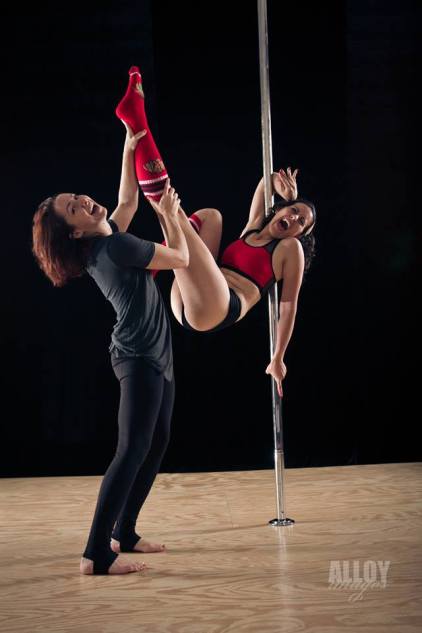
Photo by Alloy Images. Shot at The Brass Ring, featuring Iris Smoot & Manda Ritz.
EMOTIONAL COST
Teaching can be a ton of fun, and it be incredibly rewarding. Any time I see a student nail something they’ve been working hard to get, or find themselves breaking through to a new level, it is THE BEST feeling. I get so happy and so proud. I think about how far students have come, how much I love seeing them work and try and succeed, and it makes my day.
That being said: teaching can also be exhausting.
Time
If you are teaching a lot, you may not have time for yourself. You may be giving up time to do basic things, like errands, or you may be giving up time with your friends and loved ones. If you end up with classes on the weekends, guess who is not going to get to hang out with their friends who have muggle jobs? Yep.
Even if you are like me – muggle job, teaches once a week, with the occasional subbing gig – it’s still hard to make time. On nights where I teach a couple of classes in a row, I am doing it after 8 hours at my day job. I get an average of about 30 minutes of “me” time between driving home (30-45 minutes) and driving to the studio (30 minutes). I usually nap, then shove some healthy snacks into my face on the drive in. When I get home, I usually eat something, plus I still have house stuff to do, and I want to spend time with my husband, and the next thing you know, it’s midnight, and I have to be up in 6 hours. I’m usually quite tired the day after!
Beyond just time to do things and hang with your friends and family, you may also not have time to train. “But, I am teaching all the time! Of course I will train!” Eh, not always. Many instructors I know are so busy instructing others that they rarely get to take classes and be a student themselves. Nor do they always get to go to the studio and work on their own stuff.
You also have to set aside time for the administrative side of things: planning/practicing your lessons, creating/practicing/breaking down choreography, promoting your classes online with video or posters, hustling for new opportunities, etc.
Boundaries
It’s natural for students to become attached to their teachers – and vice versa! – but boundaries are important. Some students will need more attention and time, but if these requests are coming outside of class, and taking up a lot of time, there may be a need for a boundary.
Boundaries can also come into play when your friends take your class. Teaching your friends can be super fun, but if they aren’t respecting you as the instructor – goofing off, talking over you, doing moves not at the class level or part of the lesson – it can be stressful. In that case, boundaries are a must.
Last, but not least: for whom will you be working? What is the personality of the studio owner? How do they run their business? Are you okay with any of their idiosyncrasies? Or will they end up driving you insane? This is an important thing to consider – ask other instructors how they like working for the studio, and of course, use your own judgement. Nobody wants to work for a crazy, flaky person, and if you end up in that situation, boundaries will be important if you want to continue to work for them.
Giving vs. Receiving
As instructors, we give in order to allow students to flourish. Sometimes (often), one small win for a student makes it all worth it. But to put so much of ourselves into something can be draining. You have to make time to feed your own creativity and soul, in order to be of any use to others. This is important to your emotional well-being, and – surprise! – it requires time and boundaries.
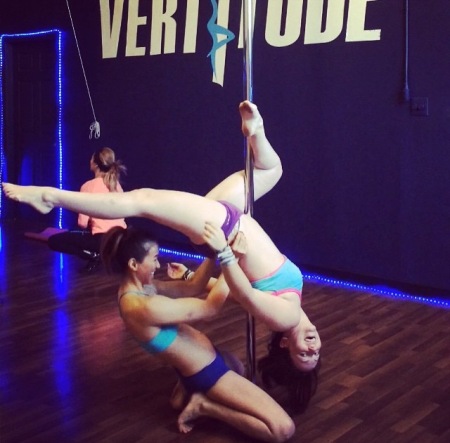
Nancy spotting me at The Vertitude. Photo is my own.
PHYSICAL COST
While we all make jokes about how our bodies change through pole, being an instructor means putting your body through different rigors. Repeating moves over and over again, spotting people properly, hours of movement, even talking through moves as you do them…it requires a lot of your body.
Recovery – Part II
I mentioned the financial cost of recovery above, but beyond that: you must take time to recover. Whether this means time off between classes to let your body rest a day or so, to taking time to roll out your muscles and stretch after class, to sit in Epsom salt baths after a hard class, or to even stopping to eat a proper meal and hydrate, it’s imperative you do it. Your body will crap out on you, if you don’t, and then you’ll be forced to take time off.
Maintenance
I’ve mentioned this twice, but diet is an important part of keeping your body in good shape. I don’t mean weight loss. At all. I mean eating the proper fuel to allow your body to function and recover at the best of its ability. This means taking the time to prep your food, and eat your food, and not rush around all the time. It means reminding yourself to keep hydrated. It’s time, and it’s money, but it’s necessary to remain in your best physical condition.
If you’re like me, and you have chronic health issues, this self-care is vital. I have to eat well, and remember my supplements, and make myself drink lots of water. And I have to get good sleep, and do all of the other recovery things I’ve already listed, just to maintain some semblance of functionality. I also have to work regularly with my Nutritionist, and see my doctors…which hey, costs more money!
IN SUMMARY
Teaching requires a lot. Despite aaaaaall of this, I truly love teaching (even when I’m tired and over it, which does happen from time to time). I had to stop teaching pole work classes for about 6 to 8 months earlier this year, due to my health issues, and I missed it. I felt so left out of the progress of my students, and I missed the community a ton. Now that I am slowly coming back to teaching regularly, and being able to pole on my own, I don’t think I realized just how much it means to me. I recently took a day off of my muggle job, just to attend an instructor jam at our studio, and spent 4 hours in the company of a handful of other polers, playing and exploring new stuff. I left SO HAPPY.
My point in putting together this exhaustive list of things to consider is simple: if you want to teach, you should be informed about every aspect of it, not just the fun and amazing things. Knowledge is power, y’all!
Note: I’ll be updating this post if any new suggestions on “cost” come to me, so check back periodically to see if anything has been added!
Not Everything Has To Be Sexy
We’re about 3 months from Halloween, and if you’re a committed costumer, you might be considering what you’ll be wearing.
Personally? I am not a Sexy [insert inane persona here] person. This is a photo of me, from last Halloween, with my friend Courtney, who made a great Sexy Mermaid:

She’s a babe all around, and her costume was great! (I was Rick from Rick & Morty. It was a joint costume with my husband, who played Morty. Photo at end of piece.)
A part of me wishes I felt comfortable in an outfit like Courtney’s. I never have. I don’t like having that much of myself on display, and that’s just my personal thing – I don’t mind if anyone else does it. More power to them. I have only dressed up as sexy anything once, when I was part of a group costume with two other friends: Sex, Drugs, and Rock & Roll. I got stuck with Sex, and I wore the outfit, but I was generally miserable. My favorite part of the costume was the faaaaaaabulous floor-length velvet jacket I borrowed from a Hollywood Wardrobe Stylist. I am really sad I couldn’t keep it. It was a goth dream.
I generally find sexy costumes to be mostly innocuous, occasionally really fun & cute (my friends dressed up as Sexy Minions last year, and it was adorable), with a few exceptions – notably, anything that falls under cultural appropriation pisses me off. Be a Sexy Banana, cool, but do you need to be a Poca-hottie? No. Full stop. That’s someone’s heritage. Not cool.
Why am I talking about this? Because I recently came across this travesty of an idea: Sexy Handmaid.
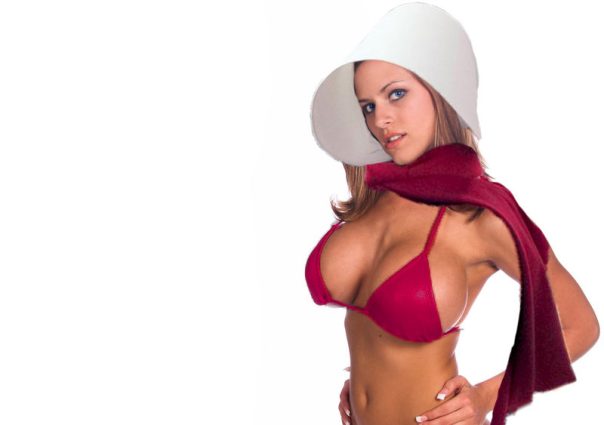
Now, that photo and the link above are from a satirical piece (thank god), BUT: the best satire is always rooted in reality, and I guarantee that we will see Sexy Handmaids this Halloween.
That’s like dressing up as Sexy Sally Hemmings, or – as the satirical piece mentions – Sexy Anne Frank.
If you have not read or watched The Handmaid’s Tale, let me enlighten you: the Handmaids are rape victims. They are sex slaves. They have no bodily autonomy. They don’t even have their own, actual names – they are given the names of the men who own them, i.e. Offred = Of Fred.
To dress up as a sexualized version of these women – even though they are fictional characters – is a smack in the face to any person who has experienced sexual violence, rape, assault, etc.
I understand the concept of trying to reclaim ownership of something for feminist purposes, and I can see where someone might consider this costume an attempt at subverting a misogynist idea, but here’s the thing: you’re still sexualizing a victim of violence while pretending to be that victim. The story within The Handmaid’s Tale is scary as hell – scarier to me than any horror movie – and by trying to transform those characters into something different – lighter, sexier – you contribute to it, rather than fight against it.
I’m a big proponent of women reclaiming their sexuality/sensuality, and I’ve spoken at length about how I believe pole can do that for women who are disenfranchised from their sexual power (and I doubt it’s only women who can experience it). I also believe that this can be achieved by other means, not just through pole. I think women can dress up as Sexy Whatevers if it allows them to feel that they have agency and bodily autonomy and ownership of their sexuality. But with that, comes the responsibility of recognizing that some shit should be left alone. In the end, being clever at the expense of others isn’t all that clever, and there are better ways to fight the patriarchy than dressing up as a “Sexy Indentured Manual Servant” (as the satirical article calls it).

Rick & Morty costume with my husband, Halloween 2016
Don’t Steal Shit: Let’s Talk About Choreo Credit
At some point, every dancer who discovers pole goes looking for inspiration. There are a lot of ways to find it: maybe it’s your teacher, maybe it’s a showcase or competition you go see, or maybe it’s a new class you try out, but I’d venture to bet that the most common means of finding inspiration is now online. Platforms like Instagram, YouTube, and Facebook allow us to find the work of other polers from across the globe.
Instagram in particular has been huge for polers. Every week, it seems like there is a new move popping up to try. With the platform’s ability to send videos to friends (and to yourself), and its new “save” feature, it’s the perfect means to save ideas to try in your next jam session. There’s also the magic of hashtags, which – thanks to an idea from Michelle Shimmy – can now be easily customized to tag specific pole moves (#pdinsertyourmovehere).
But with all of these opportunities to be inspired by the work of other polers, there is also an opportunity to ruffle feathers: taking credit for something you didn’t originate.
The first example of this with the naming of moves. I hate to break it to folks, but the chances that you have discovered a new move are pretty low. Unless you are a magical unicorn poler with skills in the top 1% of our industry, it’s fairly likely that somebody, somewhere, has probably done that thing you’re doing (and – frankly – I’ve seen famous polers co-opt moves that lesser-known polers were working on, so nobody is immune from this egocentric excitement). Without standardized names for every move, and due to the innovation happening in our industry, it’s understandable that some moves will have two, three, even five names. And that makes it tough to know if something is new, or if it’s something you just haven’t seen or heard of yet. But, my loves, remember to be humble and recognize that it’s okay that you aren’t the first person to do something. The fact that you found a cool shape or awesome move and can try it – and nail it – makes you a bad ass in your own right.
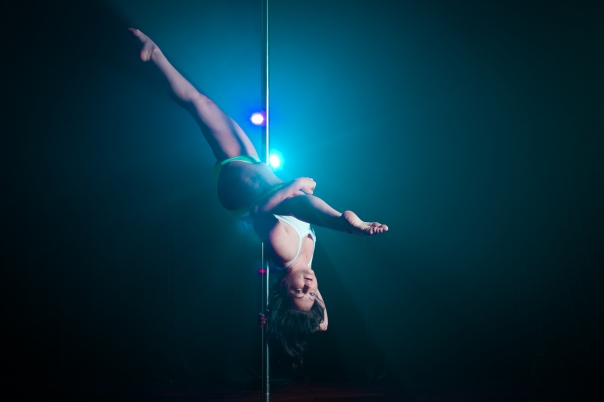
A move I spotted on Tiffany Jane, which I have been calling Jade Bird, but which may have another name! Photo by Alloy Images 2017
The second example is outright choreo theft. While this wonderful internet age has brought us the ability to see inspiration in the work of others we may never meet in person, it also means that those polers putting their work online have become vulnerable to having their work stolen. Yes, I said stolen.
These dancers work hard to create art and share it with the world. Choreography is an expression of that individual, something that they pour their heart and soul into, and to see it stolen can be a brutal and emotional experience. To rob these artists is cruel and selfish; it’s also massively lazy and rude.
Choreography theft can take place in a classroom – attending a class and teaching someone’s curriculum elsewhere, without crediting them for their creation – but most often, it happens through online videos. It’s very easy to watch, re-watch, and study clips online, to teach yourself the routines of others. Fundamentally, there’s nothing wrong with wanting to learn from the work of others, or even to emulate it, but if you are going to copy a routine, you must give credit where credit is due.
Always, always give mention to the person who inspired or created the original choreography. Tag them; give them a shout-out; make sure it’s clear that you are acknowledging their hard work and how it inspired you. Do this in classes, or when you post your videos online. It’s important, and it makes us better as an industry.
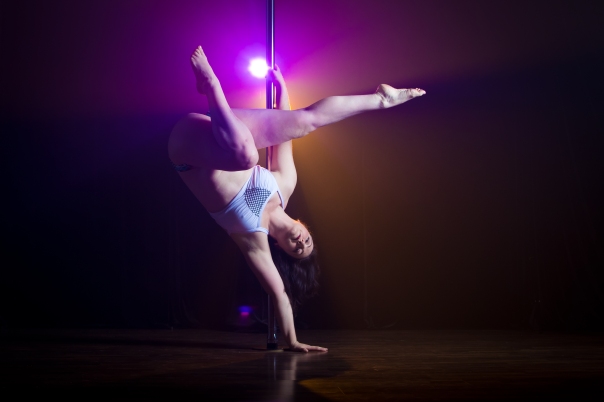
I know this move as B-Girl, and I know it as a Natasha Wang creation, but I could be wrong! Photo by Alloy Images 2017
And, when it comes to creating routines? Don’t copy. Polers who have competed or performed often put dozens of hours into a piece. They have given blood, sweat, and tears (often literally) to bring their work to life. Stealing their choreography is a violation. Just because a routine is available online does not make it acceptable for you to copy.
But, what if it’s just one part of a routine? Perhaps you like a sequence you saw, or a combo somebody made, and you want to incorporate it into your piece. Is a sequence or combo considered the same as choreography? It’s a difficult question to answer – my personal thought is no for a combo, yes for a full sequence – but your best bet is to always give credit where credit is due. A simple, “inspired by” when you post the performance video is a great idea!
If you do find yourself loving a full sequence you’ve seen in another routine, and you want to incorporate it into your own piece, you better find a way to really make it YOURS; it will make you a stronger dancer if you do you, instead of doing a knock off of last year’s winner of such-and-such (because, believe me, everyone will see it and compare it to the original…which you do not want). And, remember: credit your inspiration!
Believe Me When I Say…
Nobody wants to be the person that accidentally implies that someone else is fat.
(If you do, you miiiiight be an asshole.)
Now, we could have an entire discussion just about the concept of being fat, what constitutes it, how it becomes a means to shame others, etc. That’s not really what this post is about, or why I’m writing it, but it is an important conversation.
Let me back up a moment. During last night’s class, I tried to do the New Hot Trick (TM), called a Superstag or Gargoyle. And, I couldn’t. After numerous attempts in which I could not reach my top foot for the necessary lock, and trying to figure out the issue, it came down to me realizing that I simply could not flatten myself against my thigh enough to reach the foot.
Why? Because I carry extra weight.*
I have boobs. I have weight around my middle. Now, I’m not really plus-sized (I’m a Middler, between straight sizing and plus, at a 10/12), and I’m not really someone who carries all of my weight in my middle (not an apple, so to speak). I’m more hourglass with a bit of pear. So, I don’t think most people would look at me and think that this would be an issue in my forward fold, but it absolutely is.
In the move, I can get my chest to my leg, but the weight – the boobs, the tummy – block me from flattening. I have a good few inches of flesh in the way from squashing in enough to get to the foot.
When I tried explaining this to my instructor, she insisted it was something else, and I hit this wall of frustration. I’m still trying to unpack why, but I think I have it:
A) It’s very frustrating to not get a trick, especially one that seems like it could work for you.
B) It’s upsetting to recognize that your body is a contributing factor – and that it is something that you could, maybe, change…which makes it feel like it’s more your fault, like you’re more of a failure.
C) It’s distressing when people don’t believe you.
I think the reason why people automatically don’t believe me when I say that I have extra flesh that gets in the way is because we are (generally) conditioned to be nice. That is, nobody wants to be the person who implies that someone else is fat (or heavy, or carrying extra weight, or whatever). This is true to the point that people will outright avoid even acknowledging it, which in a weird way, almost feels worse than someone just saying, “Oh, you know, maybe that’s an issue.” Or maybe it doesn’t feel worse – I’ve never had anyone acknowledge it, and that might really suck, too!
It’s also sometimes hard to tell what is an excuse for an excuse’s sake, or what’s an excuse because it is truth (aka a reason), and that puts people in an awkward situation. So a lot of well-meaning denials occur.
It took me sitting on the floor, demonstrating that my chest and torso were fully against my leg, and that I couldn’t go any further, for my instructor to consider it for a bit. And, because she is an excellent instructor who works very hard to find variations and adjustments for people of all body types, she listened, asked questions, allowed me a space to feel heard and accepted, and we talked about possible variations to help me get it. I’m exceedingly grateful for her and the way she teaches – I know that many, many other instructors would not have done this, nor created a space the safely talk about it. I was moments away from crying in class, and probably would have gone out to my car and cried all the way home, had she not taken a moment to listen to me.
If you’re an instructor, and you have a student who has this issue, consider listening to them and working with them to find a solution/variation/alternative. Denying it does little, but listening? It can mean the world to your student.
*Now, to be fair to my instructor, she was right in a way: it’s not JUST that I have extra weight. I also am blessed with a long torso! Which is great sometimes, but when it comes to trying to reach my average arms down the length of my body to my feet in the way that is required for this move…it’s not so great. I joke about having T Rex arms, but it’s not really so much that I have short arms, as that I have a long torso and weird, limited flexibility. So, all of these things combined with my extra padding added up to me not getting this trick.
Shame
In the spring of last year, I was diagnosed with uterine fibroids. The entire reason I discovered that I had them was because of lyra: I was working on front circles, which require momentum to propel the body around the lyra in a crunch, while using the abdomen as a balance point. In short, I was repeatedly banging up my lower abdomen. After the first session of working on them, I developed spotting, which began to happen after each session (thankfully, the class stopped working on them after a couple of weeks). Then, it began to happen after any intense ab workout. Then…more frequently. And accompanied by cramps, and exhaustion. I was spending most of my weeks curled up around a heating pad.
After being diagnosed and given nothing useful to do to fix it by my doctor, I began working with my friend Ellen, who is a great nutritionist. Her fixes to my diet and supplement suggestions helped 100% – I went from being exhausted and constantly in pain, to being energized and virtually pain free in a matter of weeks.
But, I am – somewhat notoriously – not very disciplined. And that lovely, strict diet that I was so good about, slowly went back to a lot of my old habits. I introduced new foods, yes. I was mindful in certain ways. Ultimately, though, I’ve been shitty at keeping with it.
While my fibroid symptoms have not gotten nearly as bad as they were, I’m still not proud of my inability to stick to a plan.
The other thing about the fibroids is…they made scared to do pole and aerial. I would end up in pain after every class – sometimes during the class – especially if I pushed myself at all.
If I’m honest…I also unconsciously realized that I had also gained weight, which a) makes everything harder b) caused me to be uncertain about going to classes, because I hate feeling like “the one who can’t get it.”
So, I stopped going to classes. I’ll occasionally drop into a mixed level “pick a trick” style class, and I went to a few aerial classes, but for the most part…I stopped. I have only been teaching classes for the last 6 months or so, not actually going as a student.
I’ll let you guess how that impacted me.
I can no longer cleanly invert. I can barely invert. I can still do a lot of other things, and since I teach beginners, I’m not always in the position to have to invert, so while I noticed things were harder, I don’t think I realized how bad I’d gotten.
I knew I’d gained some weight, but I thought I’d just gone back to what I was before the fibroid diet. I don’t weigh myself, because I just don’t, but this weekend, I did.
I am at my heaviest that I have ever been. Which is 15lbs heavier than my old heaviest. It was a hard and horrifying blow to take.
It’s one thing to realize, “oh, yeah, I gained a bit of weight,” or to look at photos and not like what you see, but to look at a concrete number is something else. I’ve always gained weight in a really subtle way – I fill out all over, as if I have generally just swelled, so I don’t always notice it as quickly. I knew, but I didn’t know, you know?
This explains why things have been so hard for me lately. Why I can barely get my ass in the air. I’m weaker from not keeping in class, and I’m lifting more weight than ever before.
And, I’m ashamed. I feel so much shame about this: that I gained so much weight, that I wasn’t disciplined about my diet, that I can’t do the things I’m trying to teach to others. I feel like such a fraud teaching people to invert when I can’t cleanly do it myself right now. Do I have other great skills as an instructor? Totally. But shame is a powerful thing, and no amount of cheerleading from my pole bestie is going to wipe that away overnight.
This shame, ironically, makes me not want to go out. I don’t want to go to classes at this weight and struggle in front of people who have known me for years. All I can think is that they’re a) wondering why I’m struggling b) silently thinking about either how I’ve let my strength go, or how I’ve gained weight. I don’t even want to go be with my friends.
It’s not a fun place to be in.
My fiance is out of the country for the next three months, for work, which affords me a lot of extra time. With that, I’ve begin to set up more classes, and I’m going to branch out into other things. I took my first Pilates reformer class today, which I found tough, but manageable (it was for newbies) – pole has certainly given me enough conditioning for some of it to be very familiar.
And, I’m working on calming myself down when the Shame Monster goes on attack. I remind myself that it’s good that I am at least trying; that everyone struggles with something; and that the only way to get out of this hole is to start climbing.
It’s not easy. I hope I can continue with pole and aerial. I hope I can lose some of this weight (and yes, the fact that I’m getting married in 6 months is a motivating factor). I hope I can invert cleanly again, someday soon.
One Question To Never Ask Your Pole Instructor
I was recently chatting with a friend who is a pole instructor, just about classes and students, and she expressed frustration at a question that she has gotten (in her words) at least once a session:
“How long until I’m as good as you?”
That’s a difficult and dangerous question.
For my friend, it puts her in the awkward position of receiving a compliment that is also implying that her student is somehow not good enough, just as they are in the moment of the question.
Beyond that, though, is the issue of individuality. Specifically, that every person develops at their own rate. And, every person has a different set of skills and abilities. So, the truth is, that her students may never be “as good as” her. Or maybe they’ll be just as good; or, even better, someday.
Which brings up its OWN set of issues, regarding how to qualify what is “good” in the world of pole. Maybe you can do a perfect Fonji, but you have no soul in your free flow. Or, maybe you have the most passionate and fluid movement, but you never get more than 5 feet off the ground. Who is to say which is “better”?
I think it’s fairly natural to have this question cross your mind. Pole attracts people who want to improve and people who seek the validation from it. It’s part of the high for a lot of dancers – achieving new tricks, reaching new milestones. I would be willing to bet that many, many new polers have this question cross their mind.
It’s okay to think it. But, maybe, if you find yourself wanting to ask it…consider that there is no right answer. And, instead of focusing on all the things that you can’t yet do, remind yourself of all of the things you CAN do. If you couldn’t climb the pole a few weeks ago, but now you can? Celebrate that! Take a look at all of the things you have learned and give yourself a pat on the back for them! This shit is HARD, at EVERY LEVEL. Write down those accomplishments, if you have to! Be kind to yourself.
Oh, and yeah. Don’t ask that question. 🙂
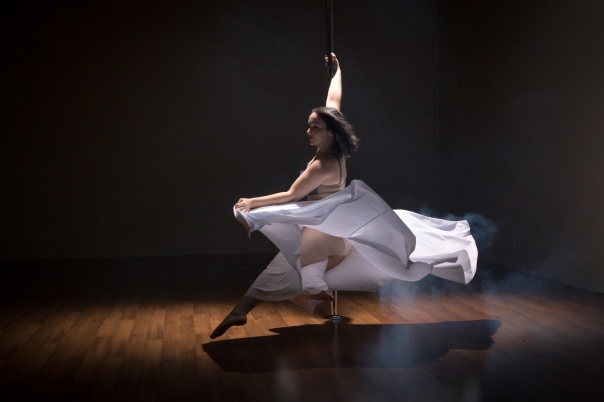
Photo by Alloy Images, 2015
Bringing Sexy Back Voting Is Open
As I mentioned in my last post, I entered the BSB Poster Girl Contest. I am on a page that features some of my sexiest friends and idols, including my loves Iris & Jamers (two of the sexiest women I know).
Why did I do this? I did it to promote body diversity. Generally, I see a lot of similar bodies in the marketing and promotion of pole. Inevitably, a certain body type is shown quite often, and while it is beautiful and should be celebrated, I get a little sad sometimes when I think about how many women don’t actually look like that. I don’t. I may never. I’m a little bigger, but not plus size. I would say, “Average American Size”, because I literally weigh right in the average window for American women. Which, to be frank, can seem big in the world of pole. As such, I struggle with how I look when I get in the studio. I have to remind myself a lot that, even on my worst days, I have something of value to share.
So, I decided to throw in one of my Alloy Images photos for the contest. My dear friend Claire helped me choose it. The story of this photo was very me: Iris found a riding crop at the studio during me shoot, and I was just messing around with it and having fun when this moment was caught. I feel like that’s pretty fitting for who I am: somebody who has moments of fire or stillness in between the laughs.
I look at my company on the voting page and see an array of amazing women. Let me be frank: ALL of them are beautiful, luscious, real women worth celebrating. All of them have something special that makes them sexy. My photo is there not so much because I feel like the sexiest of the sexy; but because I want women who don’t feel like they look like the other women on that page to feel like they too can be adored, and that they have every right to feel sexy, too. It’s something I have to remind myself about in my own life, so my guess is that I am not alone in that mentality.
Voting is now open: https://www.unitedpoleartists.com/bsb2015/ Go choose and enjoy the loveliness of all of the contestants!


